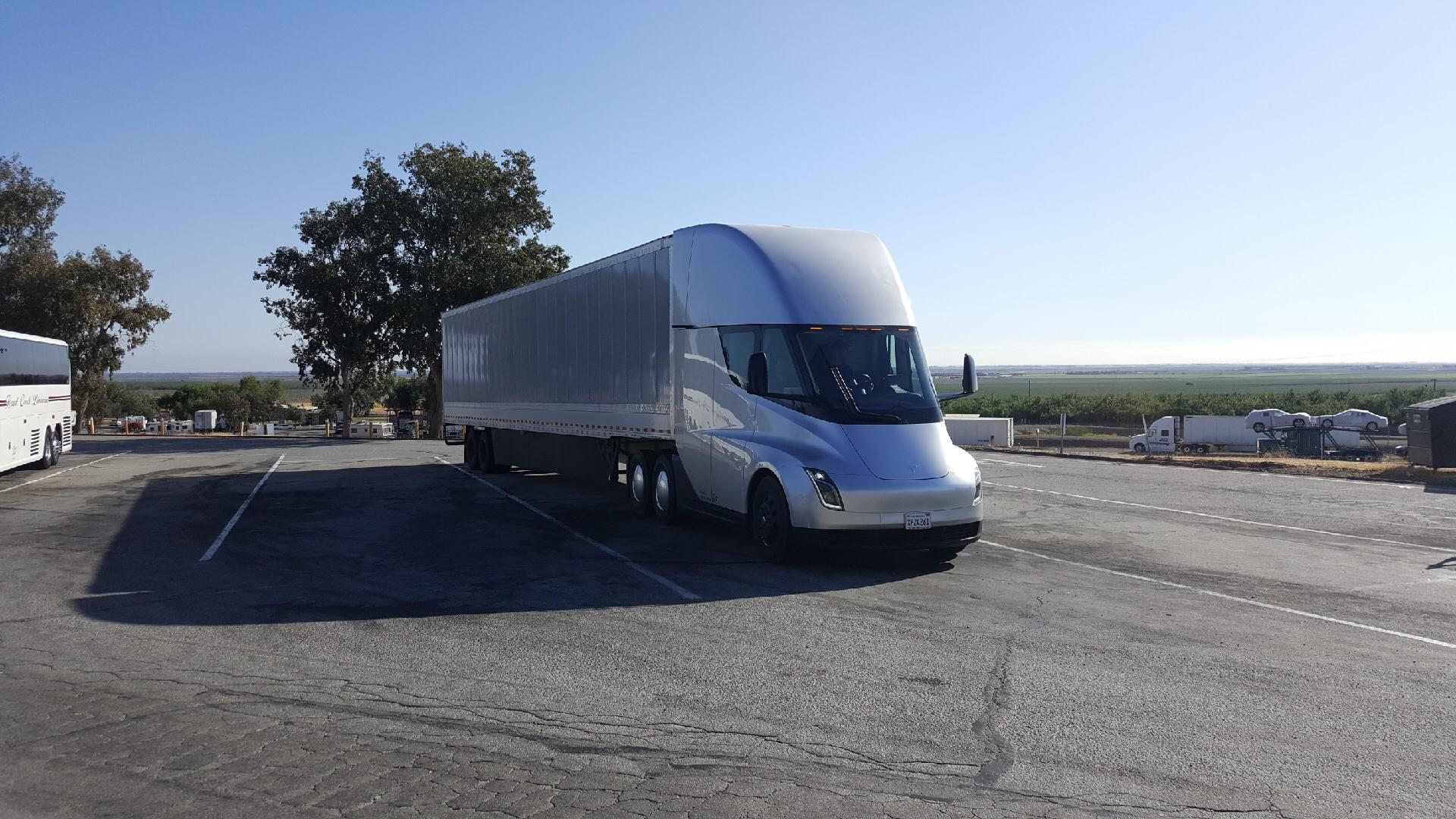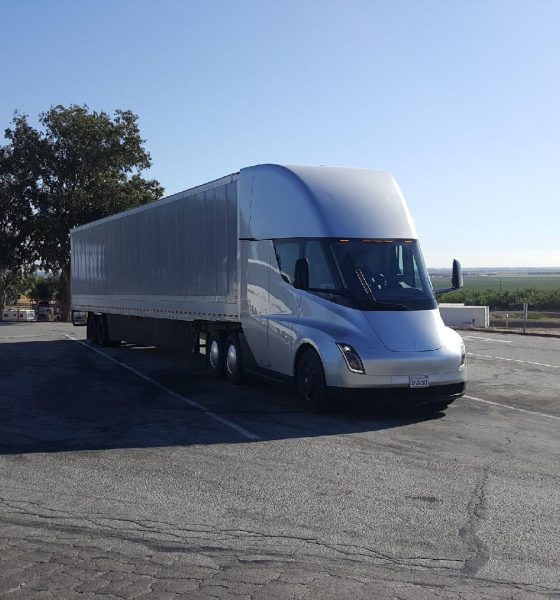

News
Tesla Semi spotted Supercharging thousands of miles from factory as real-world tests continue
Tesla’s all-electric Semi truck continues its real-world testing, with the long-hauler recently being spotted nearly 2,000 miles away from the Fremont factory at the Catoosa, Oklahoma Supercharger station, off of Interstate 44. The electric truck’s recent sighting comes a day after the vehicle was spotted cruising in New Mexico on I-40, more than 600 miles away.
The Catoosa sighting was shared on the r/TeslaMotors subreddit by Model 3 reservation holder u/JohnFitzgeraldSnow, who was able to take a photo of the truck. The electric car enthusiast mentioned that the all-electric Semi was only using a single charging cable while it was attached to a Supercharger stall. The truck was reportedly accompanied by a group of Tesla employees as well.

The latest sightings of the Semi are yet another sign that Tesla is doing some extensive real-world testing on the electric long-hauler. Among Tesla’s vehicles, the Semi would likely be the one that would rack up miles the fastest, considering that it would be tasked to transport cargo over long distances on an everyday basis. The state of the Tesla Semi in its recent sighting is proof of this, as the vehicle was pretty much covered all over with bugs from the freeway.
The Semi is designed to disrupt the trucking industry the way the Model 3 is designed to disrupt the mainstream auto market. The specs of the Semi, particularly its 500-mile range, have caught the ire of the company’s critics. Daimler’s head of trucks Martin Daum even alleged that the Semi’s quoted specs defy the laws of physics. This was laughed off by Elon Musk during the Q1 2018 earnings call, when he stated that Tesla could make a truck with 500 miles of range even with its current battery technology.
Being the largest vehicle in Tesla’s lineup, the Semi is designed to be supported by a network of high-powered Megachargers. Elon Musk noted during the Semi’s unveiling last November that the Megachargers would be capable of replenishing 400 miles of range in as little as 30 minutes of charging. The actual specs of the Megacharger have not been announced as of date, but there is a good chance that it would be roughly ten times as powerful as Tesla’s ~120 kW Superchargers.
Since being unveiled, the Tesla Semi has received a strong, positive response from several high-profile customers. In the United States alone, companies such as UPS, FedEx, Anheuser-Busch, and PepsiCo have all placed reservations for the vehicle. To prepare for the rollout of the electric trucks on America’s roads, Tesla has started building the initial charging infrastructure for the Semi. Reports emerged earlier this year that Tesla is partnering with several of the Semi’s reservation holders to build charging stations in key locations frequently traveled by fleet operators. The stations, which would likely be the first Megachargers, will be spaced close enough together so that the Semi has enough range to complete its routes.
The Tesla Semi is expected to start production sometime in 2019, and though the company has not announced where the vehicle would be manufactured, there is a good chance that the electric long-hauler’s production would be a lot smoother. The Semi, after all, shares several components with the Model 3, such as its electric motors. Considering that Tesla has learned a lot of lessons from the ramp of the Model 3, there is a good chance that the Semi might make it to market earlier than expected.

News
Tesla FSD fleet is nearing 7 billion total miles, including 2.5 billion city miles
As can be seen on Tesla’s official FSD webpage, vehicles equipped with the system have now navigated over 6.99 billion miles.

Tesla’s Full Self-Driving (Supervised) fleet is closing in on almost 7 billion total miles driven, as per data posted by the company on its official FSD webpage.
These figures hint at the massive scale of data fueling Tesla’s rapid FSD improvements, which have been quite notable as of late.
FSD mileage milestones
As can be seen on Tesla’s official FSD webpage, vehicles equipped with the system have now navigated over 6.99 billion miles. Tesla owner and avid FSD tester Whole Mars Catalog also shared a screenshot indicating that from the nearly 7 billion miles traveled by the FSD fleet, more than 2.5 billion miles were driven inside cities.
City miles are particularly valuable for complex urban scenarios like unprotected turns, pedestrian interactions, and traffic lights. This is also the difference-maker for FSD, as only complex solutions, such as Waymo’s self-driving taxis, operate similarly on inner-city streets. And even then, incidents such as the San Francisco blackouts have proven challenging for sensor-rich vehicles like Waymos.
Tesla’s data edge
Tesla has a number of advantages in the autonomous vehicle sector, one of which is the size of its fleet and the number of vehicles training FSD on real-world roads. Tesla’s nearly 7 billion FSD miles then allow the company to roll out updates that make its vehicles behave like they are being driven by experienced drivers, even if they are operating on their own.
So notable are Tesla’s improvements to FSD that NVIDIA Director of Robotics Jim Fan, after experiencing FSD v14, noted that the system is the first AI that passes what he described as a “Physical Turing Test.”
“Despite knowing exactly how robot learning works, I still find it magical watching the steering wheel turn by itself. First it feels surreal, next it becomes routine. Then, like the smartphone, taking it away actively hurts. This is how humanity gets rewired and glued to god-like technologies,” Fan wrote in a post on X.
News
Tesla starts showing how FSD will change lives in Europe
Local officials tested the system on narrow country roads and were impressed by FSD’s smooth, human-like driving, with some calling the service a game-changer for everyday life in areas that are far from urban centers.

Tesla has launched Europe’s first public shuttle service using Full Self-Driving (Supervised) in the rural Eifelkreis Bitburg-Prüm region of Germany, demonstrating how the technology can restore independence and mobility for people who struggle with limited transport options.
Local officials tested the system on narrow country roads and were impressed by FSD’s smooth, human-like driving, with some calling the service a game-changer for everyday life in areas that are far from urban centers.
Officials see real impact on rural residents
Arzfeld Mayor Johannes Kuhl and District Administrator Andreas Kruppert personally tested the Tesla shuttle service. This allowed them to see just how well FSD navigated winding lanes and rural roads confidently. Kruppert said, “Autonomous driving sounds like science fiction to many, but we simply see here that it works totally well in rural regions too.” Kuhl, for his part, also noted that FSD “feels like a very experienced driver.”
The pilot complements the area’s “Citizen Bus” program, which provides on-demand rides for elderly residents who can no longer drive themselves. Tesla Europe shared a video of a demonstration of the service, highlighting how FSD gives people their freedom back, even in places where public transport is not as prevalent.
What the Ministry for Economic Affairs and Transport says
Rhineland-Palatinate’s Minister Daniela Schmitt supported the project, praising the collaboration that made this “first of its kind in Europe” possible. As per the ministry, the rural rollout for the service shows FSD’s potential beyond major cities, and it delivers tangible benefits like grocery runs, doctor visits, and social connections for isolated residents.
“Reliable and flexible mobility is especially vital in rural areas. With the launch of a shuttle service using self-driving vehicles (FSD supervised) by Tesla in the Eifelkreis Bitburg-Prüm, an innovative pilot project is now getting underway that complements local community bus services. It is the first project of its kind in Europe.
“The result is a real gain for rural mobility: greater accessibility, more flexibility and tangible benefits for everyday life. A strong signal for innovation, cooperation and future-oriented mobility beyond urban centers,” the ministry wrote in a LinkedIn post.
News
Tesla China quietly posts Robotaxi-related job listing
Tesla China is currently seeking a Low Voltage Electrical Engineer to work on circuit board design for the company’s autonomous vehicles.

Tesla has posted a new job listing in Shanghai explicitly tied to its Robotaxi program, fueling speculation that the company is preparing to launch its dedicated autonomous ride-hailing service in China.
As noted in the listing, Tesla China is currently seeking a Low Voltage Electrical Engineer to work on circuit board design for the company’s autonomous vehicles.
Robotaxi-specific role
The listing, which was shared on social media platform X by industry watcher @tslaming, suggested that Tesla China is looking to fill the role urgently. The job listing itself specifically mentions that the person hired for the role will be working on the Low Voltage Hardware team, which would design the circuit boards that would serve as the nervous system of the Robotaxi.
Key tasks for the role, as indicated in the job listing, include collaboration with PCB layout, firmware, mechanical, program management, and validation teams, among other responsibilities. The role is based in Shanghai.
China Robotaxi launch
China represents a massive potential market for robotaxis, with its dense urban centers and supportive policies in select cities. Tesla has limited permission to roll out FSD in the country, though despite this, its vehicles have been hailed as among the best in the market when it comes to autonomous features. So far, at least, it appears that China supports Tesla’s FSD and Robotaxi rollout.
This was hinted at in November, when Tesla brought the Cybercab to the 8th China International Import Expo (CIIE) in Shanghai, marking the first time that the autonomous two-seater was brought to the Asia-Pacific region. The vehicle, despite not having a release date in China, received a significant amount of interest among the event’s attendees.








